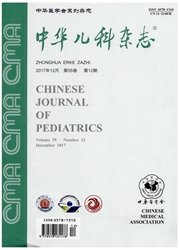

 中文摘要:
中文摘要:
目的总结早发型甲基丙二酸尿症患儿新生儿期的临床与实验室特点。方法分析160例存在新生儿期异常表现的早发型甲基丙二酸尿症患儿的临床表现、诊疗经过、生化及基因诊断资料,并对治疗效果进行随访。结果160例患儿中单独型甲基丙二酸尿症29例(18.1%),甲基丙二酸尿症合并同型半胱氨酸血症131例(81.9%)。患者新生儿期最多见的临床表现依次为喂养困难(36例)、抽搐(26例)、嗜睡(24例)、呼吸困难(17例);常规实验室检查以大细胞贫血(21例)、肝功能异常(21例)、高氨血症(14例)、代谢性酸中毒(7例)为多见;初诊以“新生儿缺氧缺血性脑病?”最多(35例)。5例(3.1%)为死亡后尸检诊断。7例(4.4%)经新生儿筛查被发现。随着年龄增长及疾病进展,患儿出现神经精神异常等复杂表现,148例(92.5%)因“智力运动障碍”、“癫痫”、“营养不良”、“贫血”、“多脏器损害”就医,于1个月-8岁5个月(平均1岁1个月)获得确诊。36例(22.5%)患儿曾有异常家族史,如:母亲不明原因流产或死胎史,同胞不明原因新生儿期死亡、癫彬惊厥、代谢性酸中毒等阳性家族史,初诊时仅有3例被考虑为遗传代谢病。31例甲基丙二酸尿症合并同型半胱氨酸血症患者接受了MMACHC基因分析,证实为CblC缺陷。160例患儿中7例死亡,153例患者经过维生素Bm叶酸、左卡尼汀、甜菜碱及特殊饮食治疗后,临床症状不同程度改善,仅2例经新生儿筛查发现的患者智力发育正常。结论早发型甲基丙二酸尿症致死率、致残率很高。喂养困难、抽搐、嗜睡、呼吸困难是甲基丙二酸尿症新生儿期常见的临床表现,常规实验室检查亦缺乏特异性,主要表现为大细胞贫血、肝损害、高氨血症及代谢性酸中毒,多数患儿合并高同型半胱氨酸血
 英文摘要:
英文摘要:
Objective Methylmalonic aciduria is the most common disorder of organic acidurias in the mainland of China. It is also the one of treatable metabolic disorders. The clinical spectrum of the patients varies from severe neonatal-onset forms with neonatal brain injury and high mortality to milder forms with adult-onset. The clinical manifestations of neonates with methylmalonic aciduria are non-specific. Early diagnosis and adequate treatment contribute a lot to improving the prognosis of the patients. In this study, the abnormal clinical and laboratory findings in neonatal period of 160 Chinese patients with early-onset methylmalonie aciduria were investigated. Method From 1996 to 2011, a total of 398 patients with methylmalonic aciduria were diagnosed in our hospital; 286 (71.9%) patients had early-onset before 1 year of age. Among 286 patients, 160 ( 55.9% ) presented symptoms in neonatal period. Their urine organic acids were analyzed by gas chromatography-mass spectrometry. Blood amino acids and acylcarnitine profiles were determined by liquid chromatography tandem mass spectrometry. Serum and urine total homocysteine were measured using a fluorescence polarization immunoassay. In some patients, gene analysis was performed. Based on the disease types and general condition, individual dietary and medical interventionswere started soon after diagnosis. Result Out of the 160 patients, 131 (81.9%) had combined methylmalonic aciduria and homocysteinemia. Isolated methylmalonic aciduria was found in 29 cases (18. 1% ). The common presentations in neonatal period were feeding difficulty, seizures, lethargy and dyspnea. Megaloblastic anemia, liver dysfunction, hyperammonemia and metabolic acidosis were the frequent findings in the routine laboratory test. The most common initial clinical diagnosis was suspected hypoxic-ischemic encephalopathy. Even in 36 cases with abnormal family history, only 3 patients were admitted with suspected inborn errors of metabolism. Five cases ( 3.1% ) were diagnosed by
 同期刊论文项目
同期刊论文项目
 同项目期刊论文
同项目期刊论文
 期刊信息
期刊信息
